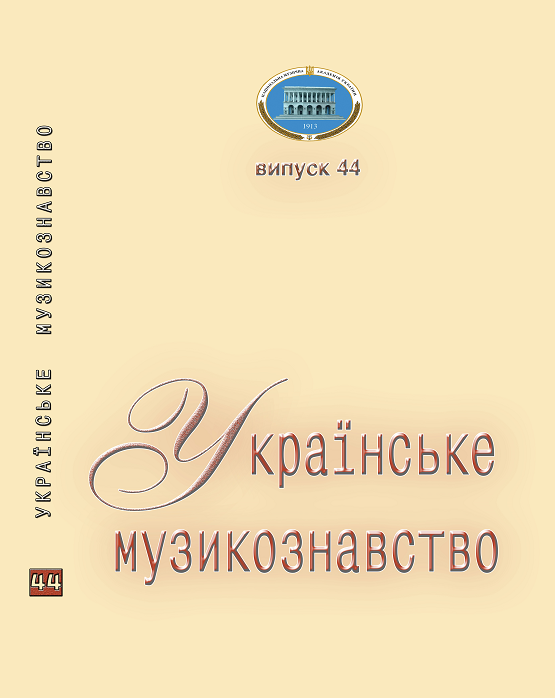Creative kontsept of bitiya in context of the postmodern culturological understanding
DOI:
https://doi.org/10.31318/0130-5298.2018.44.0.152898Keywords:
cultural space, life activity, creative activity, art, social being, artistic worldAbstract
Relevance of the study. Theoretical research and ground of art as a cultural and creative factor of development of humanity is based not only on his understanding as a process of changes, but in a greater measure as a process of saving of achievements, opening of new in attained, original method for understanding of reality.
Main objective(s) of the study. It is determined, that understanding of art as a vital world of man is linked, foremost with complication of nature of art, by connection in him theoretical and practical measuring through his submerged in reality, in the comprehension by the man of it life determining. Thus, the art is determined as a basic anthropological category, which expresses solidity of human vital functions incarnate in artistic experience.
The methodology of the research consists in the application of the general scientific principles of the objective consideration of the facts in their connections with places and importance in the history of theoretical thought, the principles of historicism and cultural analysis. Such approach allows us to form the certain system of modern theorization of the artistic fundamentals of the human life.
The scientific novelty of the work is to determine the leading tendencies that ensure the transformation of the approaches to the modern theorization of the concept «art» as the basic factor of human existence, and the actualization of its categorical system. The internal logic and evolution of the theorizing of art at the certain historical stages of the human development are highlighted. It will give us an opportunity to get closer to the dynamics of life as the art, caused by the variety of its usual manifestations in theoretical context as well as the reverse influence of the theoretical developments on the formation of the artistic paradigm of the human being.
It registers in the article, that creation of personality it is the uninterrupted process of development, updates, origins of new necessities, aspiration of man to giving of sense to all fragments of being. Thus, the element of creation with all possible senses is formed, that assists to realization of creative potencies, and permanent enrichment by higher achievements of human reason in same queue. The art is always apt at the exposure of various tints of human receptivity, predisposes a man to understanding of the greatest values, to construction of the creative measuring. The increase of role of the personality beginning in a modern culture strengthens possibilities of art in understanding of polystructural existential human being, in search of methods of decision of vital collisions by means the establishment of the individuality.
Findings and conclusions. Art is the basic component of the spiritual culture of the humanity. It has a systemic character. This thesis is based on a large theoretical knowledge of many scientists of the various cultural and historical periods, who have made a great impact in the definition of the essence and the features of the mechanism of art’s social functioning. Finally, it is impossible to consider the art out of its systemic links, elements of human culture, which are connected with the human creative activity. Their totality creates the special form of human life creativity.
References
Adorno, T. (2001), Aesthetic theory: a Textbook, [Esteticheskaya teoriya], trans. from germ. Dranova, A., Respublika, Moscow, 527 p. [in Russian]
Aristotle, (1976), Writings in 4 volumes: a Textbook, [Sochineniya v chetyireh tomah], vol. 1, Mysl`, Moscow, 550 p. [in Russian].
Baumgarten, A. (1964), Aesthetic. Writings in 5 volumes: a Textbook, [Estetika Sochineniya v pyati tomah],vol. 2, Iskusstvo, Moscow. 213 p. [in Russian].
Bualo, N. (1967), Art poetic: a Textbook, [My`stecztvo poety`chne], trans.from. fr. Rylsky, M., Mystetstvo, Kyiv, 136 p. [in Ukrainian]
Cassirer, E. (1996), «Philosophy of symbolic forms. Introduction and formulation of the problem» Culturology of the twentieth century. Anthology, [«Filosofiya simvolicheskih form. Vvedenie i postanovka problemyi», Kulturologiya ХХ v. Anthology], a Textbook, Yurist, Moscow, pp. 63–212. [in Russian].
Descartes, R. (1989), «Letter to Mersenne» Collected Works in 2 volumes, [«Py`s`mo k Mersennu», Sobrany`e sochy`neny`j v 2 tomah ], v. 1., Mysl`, Moscow, p. 597, [in Russian].
Frye, N. (1957). Anatomy of Criticism, Princeton Univ. Press, New Jersey, 383 p.[in English].
Gusserl, E. (1996), Crisis of European Humanity and Philosophy. Modern foreign philosophy. Currents and directions, [Kry`za yevropejs`kogo lyudstva i filosofiya. Suchasna zarubizhna filosofiya. Techiyi i napryamy`], a Textbook, comp. Lyakh, V. V., Pazenok, V. V., Vakler, Kyiv, pp. 62-92. [in Ukrainian].
History of European Art Studies. From antiquity to the end of the seventeenth century, (1963), [Istoriya evropeyskogo iskusstvoznaniya. Ot antichnosti do kontsa ХVІІІ veka], a Textbook, Eds. Viperi, B. P., Lichakova, T. N., Y`zdatel`stvo Akademy`y` nauk SSSR, Moscow, 436 p. [in Russian].
Lyotard, J. (1994) «Notes on the meanings of “post”» , Foreign literature. [Zametki o smyislah «post», Inostrannaya literature], no. 1. pp. 54–66. [in Russian].
Platon. (1994), Collected works in 4 volumes: a Textbook, vol.3. Nauka, Moscow, pp. 79–420. [in Russian].
Skovoroda, G. (1973), Complete collection of works: a Textbook, [Povne zibrannya tvoriv], Nauk.dumka, Kyiv, vol 1., 532 p.; vol. 2, 576 p. [in Ukrainian].
Vernadsky, V. (1944) «A few words about the noosphere», [Advances in modern biology], [Neskol`ko slov o noosfere, Uspexy`], Sovremennoj by`ology`y, no. 18, vol. 2. pp. 113-120. [in Russian].




